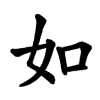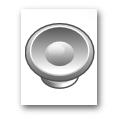Definify.com
Definition 2025
小
小
Translingual
| Stroke order | |||
|---|---|---|---|
| | |||
| Stroke order | |||
|---|---|---|---|

| |||
Han character
小 (radical 42 小+0, 3 strokes, cangjie input 弓金 (NC), four-corner 90000, composition ⿻亅八)
- Kangxi radical #42, ⼩ (“small”).
- Shuōwén Jiězì radical №15
Derived terms
References
- KangXi: page 296, character 18
- Dai Kanwa Jiten: character 7473
- Dae Jaweon: page 587, character 8
- Hanyu Da Zidian: volume 1, page 560, character 12
- Unihan data for U+5C0F
Chinese
|
simp. and trad. |
小 | |
|---|---|---|
Glyph origin
| Historical forms of the character 小
| ||||
|---|---|---|---|---|
| Oracle bone script | Bronze inscriptions | Bamboo and silk script | Large seal script | Small seal script |
 |
 |
 |
 |
 |
| Characters in the same phonetic series (小) (Zhengzhang, 2003) | |
|---|---|
| Old Chinese | |
| 觘 | *sm̥ʰreːw, *sm̥ʰreːws |
| 抄 | *sm̥ʰreːw, *sm̥ʰreːws |
| 鈔 | *sm̥ʰreːw, *sm̥ʰreːws |
| 訬 | *sm̥ʰreːw, *mewʔ |
| 炒 | *sʰroːʔ |
| 吵 | *sm̥ʰreːwʔ, *mewʔ |
| 耖 | *sm̥ʰreːws |
| 仯 | *sm̥ʰreːws |
| 眇 | *mewʔ |
| 渺 | *mewʔ |
| 杪 | *mewʔ |
| 秒 | *mewʔ |
| 篎 | *mewʔ, *mews |
| 妙 | *mews |
| 玅 | *mews |
| 釥 | *sm̥ʰewʔ |
| 小 | *smewʔ |
| 少 | *hmjewʔ, *hmjews |
| 麨 | *m̥ʰjewʔ |
| 尠 | *senʔ, *smos |
Ideogram (指事) . Two interpretations of 小 as an ideogram are possible:
- It shows a person (人) with lowered arms, implying the meaning of small. In contrast, 大 (the character for large), symbolizes a person (人) with arms outstretched.
- It shows an item divided into smaller parts 八 by a knife 亅.
In oracle bone script form, it is represented by a picture of three sand granules; compare with 少 (OC *hmjewʔ, *hmjews), represented by four dots in its oracle bone script form.
Pronunciation
- Mandarin
- Cantonese (Jyutping): siu2
- Hakka (Sixian, PFS): síau
- Min Nan (POJ): sió / siáu
- Wu (Wiktionary): xiau (T2)
- Mandarin
- (Standard Chinese, Beijing)+
- Pinyin:
- Zhuyin: ㄒㄧㄠˇ
- Wade-Giles: hsiao3
- Gwoyeu Romatzyh: sheau
- IPA (key): /ɕi̯ɑʊ̯²¹⁴/
-

- (Standard Chinese, Beijing)+
- Cantonese
- (Standard Cantonese, Guangzhou)+
- Jyutping: siu2
- Yale: síu
- Cantonese Pinyin: siu2
- IPA (key): /siːu̯³⁵/
- (Standard Cantonese, Guangzhou)+
- Hakka
- (Sixian, incl. Miaoli and Meinong)
- Pha̍k-fa-sṳ: síau
- Hakka Romanization System: xiau`
- Hagfa Pinyim: xiau3
- IPA: /ɕi̯au̯³¹/
- (Sixian, incl. Miaoli and Meinong)
- Min Nan
- (Hokkien)
- Pe̍h-ōe-jī: sió / siáu
- Tâi-lô: sió / siáu
- Phofsit Daibuun: sioir, siao
- IPA (Xiamen): /ɕiɤ⁵³/, /ɕiaʊ⁵³/
- IPA (Quanzhou): /ɕiɤ⁵⁵⁴/, /ɕiaʊ⁵⁵⁴/
- IPA (Zhangzhou): /ɕiɤ⁵³/, /ɕiaʊ⁵³/
- IPA (Taipei): /ɕio⁵³/, /ɕiaʊ⁵³/
- IPA (Kaohsiung): /ɕiɤ⁴¹/, /ɕiaʊ⁴¹/
- Note: sió - vernacular, siáu - literary.
- (Hokkien)
- Wu
- (Shanghainese)
- Wiktionary: xiau (T2)
- IPA (key): /ɕiɔ³⁴/
- (Shanghainese)
| Rime | |
|---|---|
| Character | 小 |
| Reading # | 1/1 |
| Initial (聲) | 心 (16) |
| Final (韻) | 宵 (91) |
| Tone (調) | Rising (X) |
| Openness (開合) | Open |
| Division (等) | III |
| Fanqie | 私兆切 |
| Reconstructions | |
| Zhengzhang Shangfang |
/siᴇuX/ |
| Pan Wuyun |
/siɛuX/ |
| Shao Rongfen |
/sjæuX/ |
| Edwin Pulleyblank |
/siawX/ |
| Li Rong |
/siɛuX/ |
| Wang Li |
/sĭɛuX/ |
| Bernard Karlgren |
/si̯ɛuX/ |
| Expected Mandarin Reflex |
xiǎo |
| Baxter-Sagart system 1.1 (2014) | |
|---|---|
| Character | 小 |
| Reading # | 1/1 |
| Modern Beijing (Pinyin) |
xiǎo |
| Middle Chinese |
‹ sjewX › |
| Old Chinese |
/*[s]ewʔ/ |
| English | small |
Notes for Old Chinese notations in the Baxter-Sagart system: * Parentheses "()" indicate uncertain presence; | |
| Zhengzhang system (2003) | |
|---|---|
| Character | 小 |
| Reading # | 1/1 |
| No. | 13705 |
| Phonetic component |
小 |
| Rime group |
宵 |
| Rime subdivision |
2 |
| Corresponding MC rime |
小 |
| Old Chinese |
/*smewʔ/ |
| Notes | 甲金文象沙而指小,指事字 |
Definitions
小
- small, tiny, little
- Antonyms: 大 (dà)
- 小孩 (xiǎohái, “child”)
- minor, petty
- briefly, for a short while
- 小憩 (xiǎoqì, “brief rest”)
- slightly, a little
- young
- Antonyms: 老 (lǎo)
- (the) youngest
- 小兒子 / 小儿子 ― xiǎoérzǐ ― youngest son
- a young person; child, kid, baby
- 一家老小 ― yījiālǎoxiǎo ― the entire family, old and young
- Prefix used in front of family name to indicate informality or affection (for young people, 老 (lǎo) for elder people).
- For example, Someone called 李國寶/李国宝 can be called 小李.
- (humble) my, our
- Short for 小學/小学 (xiǎoxué, “primary school”). Used only in the abbreviation of a school name.
- 二小 ― Èr Xiǎo ― No.2 Primary School
- (euphemistic, Cantonese) a euphemism of 屌 (diǎo)
- 小你! [Guangzhou Cantonese] ― Siu2 nei5! [Jyutping] ― Duck you!
Synonyms
| Dialectal synonyms of 小 (“small”) | ||
|---|---|---|
| Variety | Location | Words |
| Formal (Written Standard Chinese) | 小 | |
| Mandarin | Beijing | 小 |
| Taiwan | 小 | |
| Tianjin | 小 | |
| Jinan | 小 | |
| Xi'an | 小、碎 | |
| Wuhan | 小 | |
| Chengdu | 小 | |
| Yangzhou | 小 | |
| Hefei | 小 | |
| Cantonese | Guangzhou | 細 |
| Hong Kong | 細 | |
| Taishan | 細 | |
| Yangjiang | 細 | |
| Gan | Nanchang | 細、小 |
| Hakka | Meixian | 細 |
| Xingning | 細 | |
| Huidong (Huizhou) | 細 | |
| Qujiang | 細 | |
| Xiaosanjiang | 細 | |
| Changting | 細 | |
| Pingyu | 細 | |
| Wuping | 細 | |
| Liancheng | 細 | |
| Ninghua | 小 | |
| Ruijin | 細 | |
| Miaoli (N. Sixian) | 細 | |
| Liudui (S. Sixian) | 細 | |
| Hsinchu (Hailu) | 細 | |
| Dongshi (Dabu) | 細 | |
| Zhuolan (Raoping) | 細 | |
| Yunlin (Zhao'an) | 細 | |
| Jin | Taiyuan | 小 |
| Min Bei | Jian'ou | 小 |
| Min Dong | Fuzhou | 嫩、細 |
| Min Nan | Quanzhou | 細 |
| Xiamen | 細 | |
| Zhangzhou | 細 | |
| Taipei | 小、細 | |
| Kaohsiung | 小、細 | |
| Tainan | 小、細 | |
| Taichung | 小、細 | |
| Yilan | 小、細 | |
| Lukang | 小、細 | |
| Sanxia | 小、細 | |
| Kinmen | 小 | |
| Magong | 小 | |
| Hsinchu | 小、細 | |
| Chaozhou | 細 | |
| Wu | Suzhou | 小 |
| Wenzhou | 小、瑣 | |
| Xiang | Changsha | 細、小 |
| Shuangfeng | 細 | |
Compounds
|
|
|
Descendants
Japanese
Kanji
Readings
- Goon: しょう (shō)
- Kan’on: しょう (shō)
- Kun: ちいさい (小さい, chiisai), こ (ko), お (o), さ (sa)
- Nanori: いさら (isara), こう (kō), ささ (sasa), さざ (saza), しゃお (shao), ちいさ (chiisa)
Compounds
|
|
|
Idioms
| Kanji in this term |
|---|
| 小 |
|
しょう Grade: 1 |
| on'yomi |
Pronunciation
Noun
小 (hiragana しょう, romaji shō, historical hiragana せう)
Prefix
小 (hiragana しょう, romaji shō-, historical hiragana せう)
- less in size or quantity, small, little, short
- less in intensity, small, light, slight
- of secondary importance, secondary, sub-
- infant
Related terms
Suffix
小 (hiragana しょう, romaji -shō, historical hiragana せう)
- suffix after names of elementary schools
- 佃小
- tsukuda-shō
- Tsukuda Elementary School
- 佃小
References
- ↑ 2006, 大辞林 (Daijirin), Third Edition (in Japanese), Tōkyō: Sanseidō, ISBN 4-385-13905-9
- ↑ 1998, NHK日本語発音アクセント辞典 (NHK Japanese Pronunciation Accent Dictionary) (in Japanese), Tōkyō: NHK, ISBN 978-4-14-011112-3